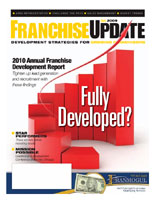2010: A Growth Odyssey?: Annual Franchise Development Report Shows Mixed Results
One of the highlights each year at Franchise Update's Leadership & Development Conference is the presentation of the 2010 Annual Franchise Development Report (AFDR). Participants represented 38,800 units (28,300 franchised, 4,600 company-owned, and 5,900 international), and they plan to add 5,360 more franchised units this year through 3,400 franchisees.
The report--which contains in-depth information on lead generation, recruitment, budgets, sales team compensation, closing ratios, and other operations vital to lead generation and franchise sales--and delivers data by industry, by unit investment, and by system-wide sales--has been used by franchisors for more than a decade to benchmark their operations in these all-important development areas. (See below for ordering details.)
Before digging into the results of the report, we would be amiss if we didn't mention that the contrast of this conference with last year's was both dramatic and palpable: you could feel it in the air, in the hallways, in the conversations, in the presentations, and even in the economic forecasts.
Not surprising, really, as last year's conference took place in late September, just as the bottom was falling out of the global economy. Where attendees were glued to the news last year and speakers were darkening their forecasts on the fly, one year later it appears the economy has bottomed out and is tilting upward, if slowly and unevenly. And if the mood of franchisor executives at this September's conference is an indicator, uncertainty, gloom, and fear have been replaced by optimism and a sense that the next 12 months are going to be a time of growth, if somewhat moderated by the recent past (and the availability of capital).
That was the "feel" and atmosphere of the conference. Now let's take a look at the numbers. The results were presented by Steve Olson, publisher of Franchise Update Media Group.
- Recruitment budgets. For 2010, both average and median recruitment budgets are expected to fall significantly, $36,000 and $50,000 respectively. "This is surprising," said Olson. If this is a sign of the times, what is it saying? Are gun-shy, risk-averse, economy-battered franchisors still more focused on improving operational efficiencies than on adding units? How much of a role has tight credit played in reduced recruitment budgets?
Where the money goes, said Olson, is "pretty much stable and consistent with previous years." Internet recruitment spending has held steady at about 50 percent since 2006. (For 5-year trends, see graphics "Recruitment Budgets" and "Where the Money Goes.") - New research. Questions about how franchisors are spending their Internet dollars--and where the payoffs are--were added this year. The lion's share (61 percent) went to online ad portals (a channel that many see as declining in ROI, though still the number-one producer of leads). Of the remaining 39 percent, 18 percent went to search engine optimization, 15 percent to pay-per-click, and 6 percent to the emerging social media.
- Top sales producers. Referrals were steady at 28 percent, "a little surprising, I think" said Olson. In fact, all five categories--Internet, referrals, brokers, print, and other (trade shows, pubic relations, etc.)--changed little from the previous year. However, in the past five years (see graphic, "Top Sales Producers"), the share of sales produced through the Internet dropped from 46 percent to 34 percent, while that of brokers nearly doubled from 9 percent in 2005 to 17 percent in 2009 (a tribute to their talents in working online leads, since most of their sales come from working this medium, he added). And print crept back up from 4 percent in 2005 to 8 percent in 2009.
- Top Internet sales producers. Among purely online sources, nearly half (46 percent) of sales came through online ad portals. One in four (26 percent) were attributed to SEO. "I am confident this can go up as franchisors improve their optimization efforts," said about SEO. Pay per click, at 8 percent, represented the lowest return in terms of spending, he said. "It's just not bringing the return it used to." And in what might best be described as a head-scratcher, nearly one in five (18 percent) responded they don't know where their Internet leads came from. (See story on page 38.)
- Online alternative resources. Social media and social networking sites (Facebook YouTube, Craigslist, etc.) were much in the news this year, and 62 of the 116 respondents (53 percent) used them for ads, videos, or press releases. While social media have proven very popular on the retail/consumer side, their value in franchise recruitment has yet to be proven. In the past year, seven franchisors attributed sales to these sources, the same number as the previous year. "It's working on the retail side, but we're not there yet on the recruitment side," said Olson. When it comes to recruitment budgets, he advised, "Don't go spend a lot of dollars there. Its time has not come. That's not to say in the future we won't crack the code."
- Lead performance. About one third (30 percent) reported leads were up, 16 percent said they were the same, and 54 percent said they were down in the past year. Olson reminded attendees that what matters most is not the number, but the quality of leads, and how many sales they generate.
- Closing ratios. Leads to sales came in at 1 percent; applications to sales at 10 percent, and discovery days to sales were 65 percent.
- Broker networks. As noted earlier, the role of brokers as sales producers has doubled in the past five years. Just over half of respondents (52 percent) used broker networks, about the same as last year. More than three in four (78 percent) of those who used brokers closed deals with them in the past year. Olson noted that brokers are highly effective with less costly investments, such as service businesses and less-expensive retail brands.
The median broker commission this year was $11,000, a drop of $2,000 from the previous year. The median of six sales through brokers was two less than the year before; and the median of applications that resulted in sales this year was 8 percent.
One area still hasn't seen a "click" between franchisors and brokers, Olson noted. "I really hope the broker community learns to work with the restaurant higher-end concepts," he said. "Once you get over half a million, they're off the radar screen." The sweet spot for brokers he said, is from under $100,000 up to $250,000 or so for retail food. But at $350,000 or $400,000, they start disconnecting from the broker community. "For larger food concepts or hotels the deals get too complex for the franchise broker. They're more attuned to closing deals in four, six, or eight weeks." - Sales goals and performance. Among this year's survey participants, 42 percent met or exceeded their sales goals (33 percent met, and 9 percent exceeded them). Olson tacked an asterisk to those numbers by noting that this was "after recognizing the challenge of 2009 and adjusting their goals." Another qualifier, he said, was that executives going into 2010 couldn't use past performance to predict future performance. "The sky was falling when budgeting was being done in the fourth quarter. Everything was unraveling."
Even with nearly six in 10 (59 percent) falling short, Olson said, "I'm surprised those below goals weren't even higher." Of the 9 percent exceeding their goals, half were service concepts, 20 percent retail food, 20 percent retail nonfood, and 10 percent were in the food category. - Unit business conditions. Of the 9 percent of franchisors that exceeded goals, 78 percent described unit business conditions as "good," 22 percent as "neutral," and none as "poor." Of the 59 percent below their goals, 28 percent described unit business conditions as "good," 40 percent as "neutral," and 31 percent as "poor."
"This is the impact of the economy," said Olson. "Segments such as casual dining got a jolt in the past year." However, he added, the negative effects were tempered somewhat by how franchisors in these segments responded, through internal and operational adjustments, as well as by providing incentives to qualified candidates. - Franchisee satisfaction. No surprise here: happy franchisees generate more referrals. Of the franchisors exceeding their goals, 40 percent of sales were from referrals; of those meeting their goals, that figure was 31 percent, dropping to 25 percent for those below their goals.
- Item 19/FPRs. Does providing financial performance representation help with meeting sales goals? Among franchisors that exceeded their goals, 70 percent provided FPR numbers in Item 19. The corresponding percentage for those meeting their goals was 61 percent, and for those who fell below their goals, it was 53 percent.
- Cost per lead. Two out of three (67 percent) of the 116 brands tracked cost per lead. The median cost per lead was $43, down $7 from the previous year--the first time it's dropped in years, Olson noted. And at $70, the average cost per lead this year was $10 less than the year before. Still, with budgets so tight, how is it that one third still don't track cost per lead?
- Cost per sale. Despite all the emphasis on reducing costs this past year, more than 4 in 10 (43 percent) of respondents still don't track how much each sale costs them. Of the 57 percent who do, the average cost per sale was $8,200, with a median of $7,000. As for those franchisors who still do not track sales in 2009, Olson expressed surprise bordering on indignation.
"There's no excuse. "With all the technology available, I just don't understand how franchisors can not do this," he said. "The good news is that those who take advantage of the technical intelligence available today separate themselves from competitors. They don't have to spend as much money to achieve the same sales results." - Resales. To shore up their brands in a tough year, many franchisors introduced resale programs or pumped up existing ones. More than half (52 percent) had formal resale programs in place, and one in five (19 percent) had a resale program in their FDD. "There is definitely more interest in protecting your brand," Olson noted. "Brand credibility drops every time you shut down a store." Consumers see it, which in turn causes potential franchise buyers to cast a more jaundiced eye on the investment opportunity of that brand.
A good resale program is a sales plus, he said, as it shows candidates not only a smooth entry path, but an exit strategy as well. It also helps to avoid the dreaded last-minute panic call from a franchisee in trouble (or worse, no contact at all). "To protect the brand, royalty stream, and provide service to the franchisee, the franchisor has to engage themselves in assisting these franchisees with exit strategies. Putting these programs in place in advance helps to smooth the transition of turning a unit over to another qualified franchisee."
Historically, he says, franchisors have been reluctant to get involved in resales for fear of legal repercussions. In recent years, however, he says franchise attorneys have been changing their tune on this and working with franchisors in the interest of protecting the brand. However, Olson cautions not to leap into resales without consulting your franchise attorney.
"If you don't have a formal resale program, you certainly should consider it," Olson advised. "Franchisors need to get actively engaged in assisting franchisees, in counseling them. The franchisee doesn't want to close their doors. They'd much rather see someone take it over, so there's a mutual interest in resales." - Referrals. After all the high-tech, online, social networking, and SEO conversations have been accounted for, referrals remain the best source of new leads in terms of close ratios for 50 percent of those surveyed. Referrals are "the lifeblood of franchising," said Olson. "They're the best quality candidates."
That's a big reason franchisors are offering incentives to franchisees who provide referrals who buy a franchise. About two thirds (65 percent) of those surveyed are providing such incentives--a 71 percent increase over the previous year--with a median referral fee of $3,500. "That's a dramatic increase," said Olson, who urged the crowd to offer incentives to boost the number of this valuable lead resource. - Incentives. "In the last 12 months, we're all trying to make our packages more attractive," said Olson. This has been particularly apparent in the incentives franchisors have been offering to qualified candidates to help them overcome their obstacles to signing. Most common were offers of reduced franchise fees, investment levels, and royalties. Some even offered to take back the franchise if specific revenue goals were not achieved by a certain date. Franchisor incentives seemed to have peaked in the first half of 2009, and have been tapering off since. Of the 116 franchisors surveyed, exactly half reduced the cost of entry in the past 12 months, in the following ways: lower investment (54 percent); lower franchise fee (19 percent); lower royalty (10 percent); and other (17 percent).
ORDER YOUR REPORT TODAY!
The 2010 Annual Franchise Development Report (AFDR) delivers data organized by industry, by unit investment, and by system-wide sales, allowing franchisors to dig deeper within their own industry categories and investment levels to compare--and benchmark--their own operations with those of similar brands. New online research is also included.
The AFDR, the only sales and lead generation benchmark report available in franchising, identifies industry sales trends and top lead generation sources for achieving growth in 2010. For example:
- What are the franchisors exceeding their sales goals doing differently than those below their goal?
- Is your online spending paying off? How do you know?
- Are your brokers delivering--and is their price per deal too high?
- How does your sales budget compare with those of other concepts?
- Are your closing ratios in line with your industry and investment level?
- Social media: how are others using it to sell units?
The 2010 AFDR is packed with timely information and benchmarking data that can help your franchise system grow faster and close more deals. Based on in-depth interviews with 116 franchise organizations actively expanding their franchise systems, this thoroughly researched report reveals the franchise success drivers sure to boost the output of your sales department.
The 2010 AFDR, packed with the most comprehensive sales and lead generation data in franchising, is a must-buy selling tool for franchisors, development consultants, and advertising and marketing suppliers. The AFDR is ideal for benchmarking and building budgets and media plans.
The complete report, with analysis and benchmarks, is available now for $399. (Note: This report does not include multi-brand franchisors; a survey will be released later with their results.)
For ordering information, call Sharon Wilkinson at 800-289-4232 x202, or go to www.franchise-update.com/magazine/franchisedevelopmentreport/
Share this Feature
Recommended Reading:
FRANCHISE TOPICS
- Multi-Unit Franchising
- Get Started in Franchising
- Franchise Growth
- Franchise Operations
- Open New Units
- Franchise Leadership
- Franchise Marketing
- Technology
- Franchise Law
- Franchise Awards
- Franchise Rankings
- Franchise Trends
- Franchise Development
- Featured Franchise Stories
FEATURED IN

Franchise Update Magazine: Issue 4, 2009








 The franchise listed above are not related to or endorsed by Franchise Update or Franchise Update Media Group. We are not engaged in, supporting, or endorsing any specific franchise, business opportunity, company or individual. No statement in this site is to be construed as a recommendation. We encourage prospective franchise buyers to perform extensive due diligence when considering a franchise opportunity.
The franchise listed above are not related to or endorsed by Franchise Update or Franchise Update Media Group. We are not engaged in, supporting, or endorsing any specific franchise, business opportunity, company or individual. No statement in this site is to be construed as a recommendation. We encourage prospective franchise buyers to perform extensive due diligence when considering a franchise opportunity.